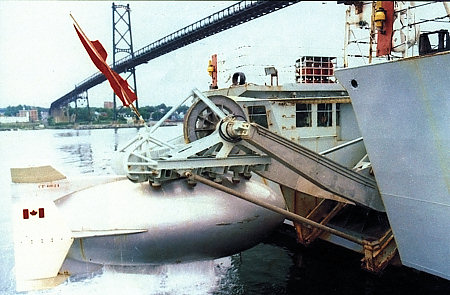|
This is a basic list of the Sonar
equipment used by the Canadian Navy during and since the Second World
War. The different sources upon which this page is based sometimes have
conflicting information and details, and some of the information seen
here has therefore been extrapolated from those conflicting sources.
In
Royal Navy (and Royal Canadian Navy) used the term ASDIC (Allied Submarine Detection Investigation Committee) until
the end of the Second World War, after which (possibly as late as the
early 1960s in the RN) they gradually changed to the USN acronym (SONAR
for SOund NAvigation and Ranging) instead. Both acronyms have entered
the vernacular to a certain extent, and are often used not capitalized.
Photographs, where available, will usually show the Sonar domes and
hull
outfits.
|
Introduction:
Hull Outfits
|
|
Sonar transducers and oscillators
are fitted on the bottom of the
hull, either within the hull itself or in sonar "domes" or hull
outfits. Sometimes the sonar dome, or hull outfit, would house the
transducers for several different sonars.
PRESTONIAN class frigates
carried Hull Outfit 810, while the Tribal class and some of the ST.
LAURENT
descended destroyers carried Hull Outfit 7 or 7A, and RESTIGOUCHE class
and newer destroyers (plus HMCS PROVIDER) carried Hull Outfit C3.
PROTECTEUR and PRESERVER were also fitted with the C3 dome, although no
sonar was ever installed there. The RESTIGOUCHE and MACKENZIE classes
were originally
fitted with both Hull Outfits 7/7A (forward) and C3 (aft) (see photo
4), but they apparently lost the
7/7A outfit
during the IRE refits. The SQS 505 and 510 sonars were installed in
Hull Outfit C3 on the IROQUOIS class, and Hull Outfit C5 on the HALIFAX
class frigates.
The 810, 7/7A, and C3 domes were originally designed so that they
could be raised into the hull for entering port, and lowered again
during sonar operation. In the case of the 7/7A domes in RN service,
they could be raised eletrically from the sonar control room as well as
the hull outfit space, and in some cases even from the ship's bridge.
This arrangement created self-noise
through the
water flowing around the dome / hull interface. Because of this, the C3
dome on many ships was fixed in the down position and faired into the
hull. The C5 dome on the HALIFAX class was faired into the hull from
the beginning, and was never intended to be raised.
According to Martin Healey:
"The C3
dome was hydraulically operated, with provision to raise and lower the
dome manually
by means of a hand operated pump, I found the system to be
reliable.
Fixing the dome in the down position reduced the amount of maintance
needed by eliminating the need to send divers down at regular
intervalls to torque the dome securing nuts.
Although the dome was fixed the transducer could still be raised or
lowered when entering or leaving harbour.
Both hull outfits 7A and 810 were raised and lowered by electic motor,
[but] in case of failure they could be raised or lowered by hand.
They could also be made water tight, this allowed the transducers to be
removed
without dry docking.
It was standard procedure every time the dome was raised to do a
watertight test, a failure
therefore indicating a damaged dome.
The hull outfit C3 was free flooding ,work on the transducer required
the ship to enter a drydock.
The dome however could be changed by divers."
|
Sources
|
ASDIC, RADAR, and
IFF
Systems Aboard HMCS HAIDA website by Jerry Proc.
Corvus Publishing Group / Canada's
Navy Annual. Various
Issues. (1985-1991)
Sonarman Trade Handbook, Group One, BRCN 3030(64).
Correspondence with M. Healey and N. Millen.
Canadian
War Museum
|
Photos 1-4: ©Sandy McClearn
Diagrams 3&4: RCN Sonarman Trade Handbook.
|
1.
Hull Outfit C5 on HALIFAX class.
|
2.
Hull Outfit C5 on HALIFAX class model. |
3.
Hull Outfit C3 on IROQUOIS class. |

|
 |
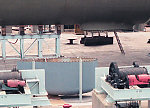 |
4.
Outfits 7 and C3 on model of DDE 261.
|
5.
Hull Outfit 810 on Prestonian class. |
6.
Hull Outfit 7A (as fitted to Tribal class). |
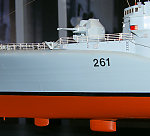
|
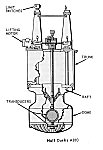 |
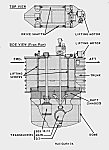 |
British Origin Sonars (Asdics)
|
|
Type
123A and 123D
|
|
Role
|
Surface ASW active
search set
|
Fitted to
|
Flower class
corvettes
|
Range
|
2500 yards under ideal conditions
|
Approximate Cdn. Service Dates
|
1940 - 1945
|
Comments
|
Due to the primitive electrical systems
on the early corvettes, these
ships had to rely on magnetic compasses, rather than more advanced and
reliable gyro compasses. The reliance on magnetic compasses limited
these ships to the older Type 123A sonar, as newer sonars required gyro
compasses. The use of magnetic compasses alone was a limiting factor,
as they were sensitive to the steel construction of the ships on which
they were mounted, and tended to bounce around in heavy seas and when
the corvettes were thrown about after dropping depth charges, which
made it difficult to plot an accurate course.
These "primitive but reliable" sonar sets used an oscillator located
under the hull which could be rotated through 360 degrees (by hand!),
but was fixed at about 6 degrees below the horizontal. As a result,
conditions under which a submarine could be located, and contact
maintained, were limited. As the oscillator was fixed in elevation, a
corvette was forced to lose contact with a targetted U-boat during the
actual attack phase where the corvette passed over the U-boat to drop
depth charges, and one tactic early in the war was for one corvette to
stand off and hold the contact while another corvette went in for the
attack. The development of the Hedgehog, and other "stand-off" weapons
later in the war, also helped to overcome this shortcoming.
The improved 123D set came about merely by adding a second magnetic
compass and bearing indicator on the bridge, and a loudspeaker system
for the sonar operator to communicate directly with bridge personnel.
The upgrade appears to have occured sometime between 1942 and 1943 for
some ships, but was never fully carried out in favour of other more
improved sonar sets.
|
Sources
|
Macpherson, K. and Milner, M. (1993). Corvettes of the Royal Canadian
Navy 1939-1945. Vanwell Publishing Ltd. St. Catherines, ON.
ASDIC, RADAR, and
IFF
Systems Aboard HMCS HAIDA website by Jerry Proc.
|
Photos
|
1.
|
2.
|
3.
|
|
|
|
|
|
Type
124
|
|
Role
|
Surface ASW active
search set |
Fitted to
|
River class
destroyers
|
Range
|
2500 yards? |
Approximate Cdn. Service Dates
|
1937-1945
|
Comments
|
An updated version of the Type 121 sonar,
this was the first sonar set to see Canadian service with the purchase
of ST. LAURENT and FRASER in 1937. These ships had gyro compasses,
which were an integral part of the sonar system.
|
Sources
|
Douglas, Sarty, Whitby, Caldwell,
Johnston, Rawling. (2002). No
Higher Purpose. Vanwell
Publishing Ltd. St.
Catherines, ON.
ASDIC, RADAR, and
IFF
Systems Aboard HMCS HAIDA website by Jerry Proc.
|
Photos
|
1.
|
2.
|
3.
|
|
|
|
|
|
Type
127D
|
|
Role
|
Surface ASW active
search set |
Fitted to
|
Flower class
corvettes, Fairmiles?
|
Range
|
2500 yards? |
Approximate Cdn. Service Dates
|
??
|
Comments
|
Macpherson and Milner indicated that the
Type 127D was an interim upgrade to early Flower class corvettes
between the fitting of Type 123 and the later, much improved, Type 144
set. The Type 127D introduced motorized rotation of the oscillator, and
the oscillator was stabilized to maintain a constant attitude
regardless of the movement of the ship. The Type 127D also required a
gyro compass, and required that the ships be rewired with a low power
system. In addition, the Type 127D could be used in conjunction with
the new Hedgehog ASW mortar, although without complete integration
between the two.
Jerry Proc's material (see link below) indicates that the Type 127D
sonar was also used in Fairmile motor launches.
|
Sources
|
Macpherson, K. and Milner, M. (1993). Corvettes of the Royal Canadian
Navy 1939-1945. Vanwell Publishing Ltd. St. Catherines, ON.
ASDIC, RADAR, and
IFF
Systems Aboard HMCS HAIDA website by Jerry Proc.
|
Photos
|
1.
|
2.
|
3.
|
|
|
|
|
|
Type
128 and 128A
|
|
Role
|
Surface ASW active
search set |
Fitted to
|
River class
frigates and BANGOR class
minsweepers
|
Range
|
2500 yards?
|
Approximate Cdn. Service Dates
|
1941-1946, Type 128A from 1943.
|
Comments
|
An improved version of the Type 127D with
a retractable dome.
|
Sources
|
ASDIC,
RADAR, and IFF
Systems Aboard HMCS HAIDA website by Jerry Proc.
|
Photos
|
1.
|
2.
|
3.
|
|
|
|
|
|
Type
132
|
|
Role
|
Hydrophone (passive, or
listening) set |
Fitted to
|
Tribal
class destroyers, cruisers?
|
Range
|
Up to one mile to detect sound of torpedo
propellers
|
Approximate Cdn. Service Dates
|
1943 - 1950?
|
Comments
|
Hydrophone sonar set used on some
destroyers and cruisers to detect presence of submarines and torpedoes
for avoidance purposes.
|
Sources
|
ASDIC,
RADAR, and IFF
Systems Aboard HMCS HAIDA website by Jerry Proc.
|
Photos
|
1.
|
2.
|
3.
|
|
|
|
|
|
Type
144 and 144Q
|
|
Role
|
Surface ASW active
search and attack sonar
|
Fitted to
|
Flower
and Castle
class corvettes, River
class frigates, Tribal
class destroyers
|
Range
|
2500 yards (1200 maximum for Q
attachment) |
Approximate Cdn. Service Dates
|
1943-1950?
|
Comments
|
An improved sonar set with a fixed
gyro-stabilized oscillator that used a gyro compass for bearing
indication. The Type 144 was fully integrated with the Hedgehog or
Squid ASW
mortars. The Type 144Q was a Type 144 sonar with a "Q" attachment,
which
was a
second oscillator that trained with the main oscillator, but was
elevated down further for maintaining contact with the target at close
range (possibly around 400 yards).
See Jerry Proc's website (link below) for an excellent description of
these sonars, as well as a diagram showing how the Type 144, 144Q, and
147F worked together.
According to Norrie Millen (retired Royal Navy):
"I think under ideal
conditions a range of 2800 – 3000 yards was possible, all depending on
sea state, temperature of water etc. Q and Q2 [attachments] were used
for close range and the switch was made just before instant echoes
[were] reached to ensure target was not lost. I do not remember
switching to Q at 1200 yards. I had 144 on my 3rd ship (1961-63)"
|
Sources
|
Macpherson, K. and Milner, M. (1993). Corvettes of the Royal Canadian
Navy 1939-1945. Vanwell Publishing Ltd. St. Catherines, ON.
ASDIC, RADAR, and
IFF
Systems Aboard HMCS HAIDA website by Jerry Proc.
Naval
Electronics website by Andrew Cashmore.
Correspondence with M. Healey and N. Millen.
|
Photos
|
1.
|
2.
|
3.
|
|
|
|
|
|
Type
145 and 145Q
|
|
Role
|
Surface ASW active
search and attack sonar |
Fitted to
|
Flower class
corvettes
|
Range
|
2500 yards (1200 maximum for Q attachment)
|
Approximate Cdn. Service Dates
|
1944-?
|
Comments
|
Basically the same as the Type 144 set,
but with a portable dome. The Type 145 was the intended sonar upgrade
for all corvettes, but many only received the Type 144.
|
Sources
|
Macpherson, K. and Milner, M. (1993). Corvettes of the Royal Canadian
Navy 1939-1945. Vanwell Publishing Ltd. St. Catherines, ON.
ASDIC, RADAR, and
IFF
Systems Aboard HMCS HAIDA website by Jerry Proc.
|
Photos
|
1.
|
2.
|
3.
|
|
|
|
|
|
Type
147B and 147F
|
|
Role
|
Depth finding secondary
sonar
|
Fitted to
|
Tribal
class destroyers, PRESTONIAN
class
frigates |
Range
|
1000 yards
|
Approximate Cdn. Service Dates
|
1943 - 1950?
|
Comments
|
This depth finding set was intended to be
installed alongside the Type 144/145/164 search sonars to help operate
Hedgehog and Squid ASW mortars.
|
Sources
|
ASDIC,
RADAR, and IFF
Systems Aboard HMCS HAIDA website by Jerry Proc.
Correspondence with N. Millen.
|
Photos
|
1.
|
2.
|
3.
|
|
|
|
|
|
Type
162 (SQS 501) "Tracer" or "Sounder"
|
|
Role
|
Ocean bottom profiler
|
Fitted to
|
PRESTONIAN
class
frigates, Tribal,
ST.
LAURENT, RESTIGOUCHE,
MACKENZIE,
ANNAPOLIS,
and IROQUOIS
class destroyers
|
Range
|
1800 feet
|
Approximate Cdn. Service Dates
|
1950 to early 1990s.
|
Comments
|
This set was used to identify targets on
the ocean bottom in shallow waters. Obtained the Canadian designation
(SQS
501). Otherwise known as "Tracer" (RCN) or "Sounder" (RN).
|
Sources
|
ASDIC,
RADAR, and IFF
Systems Aboard HMCS HAIDA website by Jerry Proc.
Correspondence with M. Healey and N. Millen.
|
Photos
|
1.
|
2.
|
3.
|
|
|
|
|
|
Type
164B
|
|
Role
|
Surface ASW active
search and attack sonar |
Fitted to
|
Tribal
class destroyers, PRESTONIAN
class
frigates
|
Range
|
2500 yards (possibly up to 3000 yards
under ideal conditions)
|
Approximate Cdn. Service Dates
|
1950 - 1967
|
Comments
|
Apparently similar to, or a modification
of, the Type 144Q sonar, the Type 164B was a combined search and attack
sonar that was used with the Squid ASW mortar. As with the Type 144Q,
the Type 164B carried the Q attachment for close range detection
(around 400 yards).
Diagrams 1&2 show the Type 164 transducer and Q attachment
transducer installed in two different hull outfits.
|
Sources
|
ASDIC,
RADAR, and IFF
Systems Aboard HMCS HAIDA website by Jerry Proc.
Naval
Electronics website by Andrew Cashmore.
Sonarman Trade Handbook, Group One, BRCN 3030(64).
Correspondence with M. Healey and N. Millen.
|
Diagrams 1&2: RCN Sonarman Trade
Handbook.
|
1. Hull Outfit 810 on Prestonian class.
|
2. Hull Outfit 7A on Tribal class.
|
3.
|

|

|
|
|
|
Type
170 (SQS 502) "Attacker"
|
|
Role
|
Attack sonar (Limbo
mortar control)
|
Fitted to
|
CRESCENT and
ALGONQUIN, ST.
LAURENT, RESTIGOUCHE,
MACKENZIE,
and
possibly ANNAPOLIS
class destroyers
|
Range
|
1000 - 3000 yards
|
Approximate Cdn. Service Dates
|
1955 - early 1990s?
|
Comments
|
A high frequency attack sonar integrated
with the Limbo ASW mortar to control firing. It received the Canadian
designation of SQS 502. If the Type 170 remained in service until the
1990s, it likely only did so in the original ST. LAURENT class ships.
The Type 170 was reportedly removed from the four Improved RESTIGOUCHE
ships in
the late 1960s, and replaced with a AN\SYQ 501 V digital computer that
handled fire control for the Limbo mortar and ASROC. Ships fitted with
the SQS 505 sonar did not require Type 170 for mortar control.
According to Tom Fullerton, ST. LAURENT (and possibly CRESCENT and
ALGONQUIN) carried the original British Type 170 as opposed to the
Canadian SQS 502 version. Furthermore:
"Directly behind the
center operator's position would have been where
the "SCO" (sonar control officer) stood, wearing headphones and having
a microphone hanging down from the deckhead. It appears in [Photo
1].
The SCO's headphones were split - in one ear he could switch between
the 3 main sonar sets, with the other he could listen to (and talk
with) the ops room outside the door. [During an exercise] once we
had good sonar contact, I would pretend to
squeeze the firing pistol above my head for a pretend mortar attack.
One of the squadron commander's assistants would roll the dice, and if
we
won, the sub was considered to have been sunk. At that point
someone
in the ops room would grab the mike and call, "Sierra, sierra, sierra,"
which I presume meant that the sub should give up, having been "sunk"."
From Martin Healey regarding mortar control:
"The 502 display
system included an analog computer that solved the fire control problem
and aimed the [Limbo] mortar Mk.10.
This computer was removed along with the the 502 display, 502 sonar
system,
and one mortar mounting [from four RESTIGOUCHE class ships during IRE
refits].
An ASROC launcher was added, [and] the ships' stern was modified to
accomodate the AN/SQS 505 Variable
Depth Sonar.
The AN/SYQ 501V computer controlled the ASROC and mortars, it also
interfaced with the 505
displays."
From Norrie Millen (retired Royal Navy):
"[The Limbo] Mortar
Mk 10, had a much longer barrel that the older Mk.4 Squid [mortar] and
had a far better control system which had a mechanical computer as part
of the 170 sonar to calculate exactly when and where to fire the
weapon. [The] range of 1000 yards is way off the mark, 3000 yards + is
more like it. In the RN, the SCO was the Sonar Control Operator
(normally a UC1 rating) who had an elevated chair on a rostrum to
observe and control all of the sonar sets. We did not roll dice,
a Scare Charge was dropped and if we had a “hit”, the submarine would
fire a smoke candle. [In RN service] the Sonar Type 177 and 177M (code
name was “Hunter” initially then renamed “Searcher”) worked in
conjunction with 170B and was a medium range sonar with a range of
20,000 yards. When the range closed, "Attacker" would take over to
deliver the A/S weapon or alternatively the Helicopter would be
launched to carry out a torpedo MATCH attack fom long range."
|
Sources
|
ASDIC,
RADAR, and IFF
Systems Aboard HMCS HAIDA website by Jerry Proc.
Corvus Publishing Group / Canada's
Navy Annual. Various
Issues. (1985-1991)
Correspondence with M. Healey, T. Fullerton, and N. Millen.
|
Photo 1: Courtesy Corvus Pub. Grp.
|
1. SQS 502 simulator (or trainer). |
2.
|
3.
|
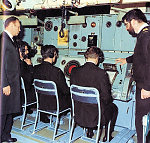 |
|
|
|
|
Type
187
|
|
Role
|
Submarine active /
passive attack sonar
|
Fitted to
|
OBERON class
submarines (pre-1989)
|
Range
|
??
|
Approximate Cdn. Service Dates
|
1965 - 1989
|
Comments
|
Primary sonar on OBERON class submarines
before SOUP refit and replacement with Triton sonar around 1989.
|
Sources
|
Perkins, J. David. (2000). The Canadian Submarine Service in
Review. Vanwell Publishing Ltd. St. Catherines, ON.
Conway's
All the World's Fighting Ships 1947-1982. Conway Maritime Press
Ltd. (1983).
Corvus Publishing Group / Canada's
Navy Annual. Various
Issues. (1985-1991)
Naval
Electronics website by Andrew Cashmore. |
Photos 1, 3: © Sandy McClearn
Photo 2: Courtesy Corvus Pub. Grp.
|
1. On HMS ONYX.
|
2. On RCN O-boat during refit.
|
3. On ex-HMS OLYMPUS
|
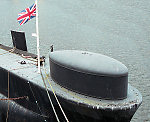
|
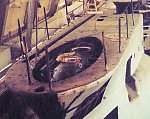
|
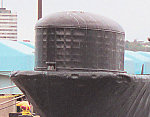
|
|
|
Type
199
|
RN
designation for Canadian developed SQS 504 "Diver" variable depth sonar
(VDS). See below in Canadian section.
|
|
|
Type
2007
|
|
Role
|
Passive VLF flank sonar |
Fitted to
|
OBERON class
submarines
|
Range
|
1800 feet
|
Approximate Cdn. Service Dates
|
1965 - late 1980s.
|
Comments
|
Original passive flank sonar (it was
fitted around the submarine's ballast tanks) on the OBERON class. This
system was apparently retained even after the addition of the new
SUBTASS combined towed array and flank array.
|
Sources
|
Conway's
All the World's Fighting Ships 1947-1982. Conway Maritime Press
Ltd. (1983).
Naval
Electronics website by Andrew Cashmore. |
Photos
|
1.
|
2.
|
3.
|
|
|
|
|
|
Type
2040 "Argonaute"
|
|
Role
|
Submarine active /
passive bow array sonar
|
Fitted to
|
VICTORIA
class
|
Range
|
??
|
Approximate Cdn. Service Dates
|
2000 to present
|
Comments
|
French Thomson Sintra sonar.
|
Sources
|
Perkins, J. David. (2000). The Canadian Submarine Service in
Review. Vanwell Publishing Ltd. St. Catherines, ON.
Conway's
All the World's Fighting Ships 1947-1982. Conway Maritime Press
Ltd. (1983).
Naval
Electronics website by Andrew Cashmore. |
Photos
|
1.
|
2.
|
3.
|
|
|
|
|
|
Type
2051 Triton
|
|
Role
|
Submarine active /
passive search and attack sonar |
Fitted to
|
OBERON class
(post-1989)
|
Range
|
|
Approximate Cdn. Service Dates
|
1989 - 2000
|
Comments
|
New bow sonar with faired dome fitted to
OBERON class submarines after 1989.
|
Sources
|
Perkins,
J. David. (2000). The
Canadian Submarine Service in Review. Vanwell Publishing Ltd.
St. Catherines, ON.
Conway's
All the World's Fighting Ships 1947-1982. Conway Maritime Press
Ltd. (1983).
Naval
Electronics website by Andrew Cashmore. |
Photo 1: © Sandy McClearn
|
1.
|
2.
|
3.
|
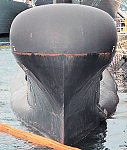
|
|
|
|
|
United States Origin Sonars
|
|
AQA-5
"Jezebel"
|
|
Role
|
Sonar trace display
|
Fitted to
|
NIPIGON,
YUKON,
some RESTIGOUCHE
class
destroyers, IROQUOIS
class.
|
Range
|
??
|
Approximate Cdn. Service Dates
|
1980s to 1990s
|
Comments
|
Technically not a sonar, Jezebel made a
paper trace of frequencies received from passive sonobuoys. The name
"Jezebel" seems to have been used to describe a family of sonobuoy
receiver systems that were originally developed for airborne use.
|
Sources
|
Corvus Publishing Group / Canada's Navy Annual.
Various
Issues. (1985-1991)
Personal
Accounts of Work and Life at NADC
ST. LAURENT class destroyer tables by
Mike Potter.
Canadian
War Museum
|
Photo 1: © DND / CWM.
|
1. Jezebel sonobuoy.
|
2.
|
3.
|
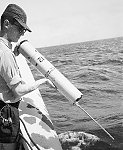
|
|
|
|
|
BQG
502 "Ranger"
|
|
Role
|
Passive ranging sonar
|
Fitted to
|
OBERON class
(post-SOUP)
|
Range
|
|
Approximate Cdn. Service Dates
|
1980s to late 1990s
|
Comments
|
Sperry Micro-PUFFS sonar fitted to OBERON
class submarines during SOUP refits. The sonar was installed in the
casing in various locations, and could be identified by the "soft
patch" markings (see Photo 1). Passive ranging provides target
course, speed, and range. PUFFS systems consisted of hydrophones
distributed along the length of the submarine for triangulation.
|
Sources
|
Perkins, J. David. (2000). The Canadian Submarine Service in
Review. Vanwell Publishing Ltd. St. Catherines, ON.
Conway's
All the World's Fighting Ships 1947-1982. Conway Maritime Press
Ltd. (1983).
Corvus Publishing Group / Canada's
Navy Annual. Various
Issues. (1985-1991)
|
Photo 1: Courtesy Corvus Pub. Grp.
|
1.
|
2.
|
3.
|
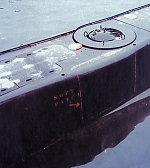
|
|
|
|
|
SQS
10 / SQS 11 "Scanner"
|
|
Role
|
Hull mounted scanning
sonar
|
Fitted to
|
Tribal,
ST.
LAURENT, RESTIGOUCHE,
and MACKENZIE
class destroyers.
|
Range
|
Up to 6000 yards
|
Approximate Cdn. Service Dates
|
1953 - 1994
|
Comments
|
Fitted in Hull Outfit 7 or 7A. The SQS 10
and 11 were essentially different models of the same sonar, which
operated at different frequencies and power outputs. A ship would be
fitted with either the 10 or the 11, but not both. These sonars used a
transducer, instead of the oscillators of the earlier wartime sonars.
Diagram 1 below shows the SQS 10/11 transducer installed in Hull Outfit
7A alongside a Type 164.
|
Sources
|
ASDIC,
RADAR, and IFF
Systems Aboard HMCS HAIDA website by Jerry Proc.
Sonarman Trade Handbook, Group One, BRCN 3030(64).
Correspondence with M. Healey and T. Fullerton.
|
Diagram 1: RCN Sonarman Trade Handbook.
|
1. Hull Outfit 7A on Tribal class.
|
2.
|
3.
|
 |
|
|
|
|
SUBTASS
|
|
Role
|
Combined Towed Array and
Flank Array
|
Fitted to
|
OBERON class
(post-SOUP)
|
Range
|
??
|
Approximate Cdn. Service Dates
|
1986 - 2000
|
Comments
|
"Submarine Towed Array Sonar System." A
towed array sonar system retrofitted to the three OBERON class
submarines during the SOUP refits.
|
Sources
|
Perkins,
J. David. (2000). The
Canadian Submarine Service in
Review. Vanwell Publishing Ltd. St. Catherines, ON. |
Photos
|
1.
|
2.
|
3.
|
|
|
|
|
|
UQC-1B
"Gertrude"
|
|
Role
|
Underwater telephone
|
Fitted to
|
ST.
LAURENT, RESTIGOUCHE,
MACKENZIE,
ANNAPOLIS,
and IROQUOIS
class destroyers.
|
Range
|
??
|
Approximate Cdn. Service Dates
|
1955 - ??
|
Comments
|
"Useable as non-directional broadband
passive sonar" according to Mike Potter.
From Tom Fullerton:
"I remember the
underwater telephone, not because we ever used it, but
because at one point I was sent below to rebuild the transmitter. The
only time it was ever used, in my recollection, was during an exercise
with a "friendly." Once we had good sonar contact, I would pretend to
squeeze the firing pistol above my head [at the SQS 502 station] for a
pretend [Limbo] mortar attack.
One of the squadron commander's assistants would roll the dice, and if
we
won, the sub was considered to have been sunk. At that point
someone
in the ops room would grab the mike and call, "Sierra, sierra, sierra,"
which I presume meant that the sub should give up, having been "sunk"."
|
Sources
|
ASDIC,
RADAR, and IFF
Systems Aboard HMCS HAIDA website by Jerry Proc.
Corvus Publishing Group / Canada's
Navy Annual. Various
Issues. (1985-1991)
ST. LAURENT class destroyer tables by
Mike Potter.
Correspondence with M. Healey and T. Fullerton.
|
Photos
|
1.
|
2.
|
3.
|
|
|
|
|
Canadian Origin Sonars
|
|
C-TECH
Mine Avoidance
|
|
Role
|
Mine detection
|
Fitted to
|
ATHABASKAN,
TERRA
NOVA, PROTECTEUR
|
Range
|
200 to 4000 metres (estimated)
|
Approximate Cdn. Service Dates
|
1990-1991
|
Comments
|
Commercial fish-finder sonar fitted to
ships that participated in the 1990 / 1991 Gulf War. On ATHABASKAN and
TERRA NOVA this sonar was installed in the main dome that housed the
SQS 505 sonar, but on PROTECTEUR it was bolted right onto the
hull near the bow, and ended up falling off before the ship arrived in
the Persian Gulf.
|
Sources
|
Miller,
Commodore Duncan E., and Hobson, Sharon. (1995). The Persian Excursion - The
Canadian Navy in the Gulf War. The Canadian Peacekeeping Press
and The Canadian Institute of Strategic Studies. |
Photos
|
1.
|
2.
|
3.
|
|
|
|
|
|
SQS
503 "Searcher"
|
|
Role
|
Hull mounted scanning
sonar |
Fitted to
|
RESTIGOUCHE,
MACKENZIE,
and ANNAPOLIS
class destroyers, PROVIDER
|
Range
|
Greater than 6000 yards
|
Approximate Cdn. Service Dates
|
1958 - 1980s
|
Comments
|
Scanning sonar made by EDO Canada, it was
similar to the SQS 10/11 sonar but had a larger transducer and operated
at a lower frequency, which provided increased range over the 10/11.
|
Sources
|
ASDIC,
RADAR, and IFF
Systems Aboard HMCS HAIDA website by Jerry Proc.
Corvus Publishing Group / Canada's
Navy Annual. Various
Issues. (1985-1991)
Correspondence with M. Healey and T. Fullerton.
ST. LAURENT class destroyer tables by
Mike Potter.
|
Photos
|
1.
|
2.
|
3.
|
|
|
|
|
|
SQS
504 "Diver"
|
|
Role
|
Variable Depth Sonar
(VDS), medium frequency active search sonar
|
Fitted to
|
CRESCENT,
ALGONQUIN, ST.
LAURENT and ANNAPOLIS
class destroyers
|
Range
|
??
|
Approximate Cdn. Service Dates
|
1961 - 1994
|
Comments
|
VDS was a Canadian development, and
started with the installation of the CAST1 prototype set in HMCS
CRUSADER from 1955 to 1960. The SQS 504 was developed from this
program, and was installed for trials purposes in CRESCENT from 1961 to
1963, after which it entered active service on the ships listed above.
This sonar was adopted by the Royal Navy as the Type 199 (see Photo 3).
The VDS was very effective on the North Atlantic, but less so in
shallower and warmer waters.
|
Sources
|
ASDIC,
RADAR, and IFF
Systems Aboard HMCS HAIDA website by Jerry Proc.
Corvus Publishing Group / Canada's
Navy Annual. Various
Issues. (1985-1991)
Correspondence with M. Healey.
ST. LAURENT class destroyer tables by
Mike Potter.
|
Photos 1&2: Cour. Corvus Pub. Grp.
Photo 3:
© M.D. Thomas
|
1. On NIPIGON.
|
2. On ASSINIBOINE.
|
3. On RN LEANDER class.
|
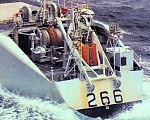
|
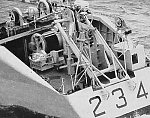
|
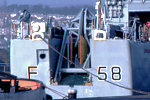 |
|
|
SQS
505
|
|
Role
|
Hull mounted and VDS,
medium frequency active / passive search sonar
|
Fitted to
|
RESTIGOUCHE,
ANNAPOLIS,
and IROQUOIS
class destroyers, plus HALIFAX
class frigates.
|
Range
|
12,000 yards, up to 27,000 yards under
ideal conditions
|
Approximate Cdn. Service Dates
|
1968 - 1997
|
Comments
|
Originally installed as a VDS on
RESTIGOUCHE class ships, the hull mounted version was installed in
IROQUOIS class destroyers and later retrofitted to RESTIGOUCHE and
ANNAPOLIS class ships during DELEX refits, at which time the ANNAPOLIS
class had their SQS 504 VDS replaced with an SQS 505 model. The SQS 505
sonar replaced the earlier SQS 502, 503, and 10/11 sonars. An improved
SQS 505 (V) set was tested in NIPIGON, and appears to have been renamed
the SQS 510 (V).
|
Sources
|
Barrie, Ron and Macpherson, Ken. (1996). Cadillac
of
Destroyers: HMCS ST. LAURENT and Her Successors. Vanwell Publishing
Ltd. St. Catherines, Ont.
Corvus Publishing Group / Canada's
Navy Annual. Various
Issues. (1985-1991)
ASDIC,
RADAR, and IFF
Systems Aboard HMCS HAIDA website by Jerry Proc.
ST. LAURENT class destroyer tables by
Mike Potter.
|
Photo 1: Courtesy Corvus Pub. Grp.
Photos 2&3: © Sandy McClearn
|
1. VDS on IROQUOIS class.
|
2. Hull Outfit C5 on HALIFAX class.
|
3. Hull Outfit C3 on IROQUOIS class. |

|

|
 |
|
|
SQS
507 "Helen"
|
|
Role
|
Lightweight variable
depth sonar
|
Fitted to
|
Intended for HMCS
BRAS D'OR, but never fitted.
|
Range
|
unknown
|
Approximate Cdn. Service Dates
|
Never entered service.
|
Comments
|
Developed by Canadian Westinghouse
as part of the hydrofoil project, but never fitted to BRAS D'OR before
the project was cancelled.
|
Sources
|
Lynch, Thomas G. (1983). The Flying 400 - Canada's
Hydrofoil Project. Nimbus Publishing Ltd., Halifax, NS.
|
Photos
|
1.
|
2.
|
3.
|
|
|
|
|
|
|
SQR
501 (SQR 19V) CANTASS
|
|
Role
|
Low frequency passive
tactical towed array sonar
|
Fitted to
|
ANNAPOLIS
class destroyers, HALIFAX
class
frigates, VICTORIA
class submarines
|
Range
|
??
|
Approximate Cdn. Service Dates
|
1992 - present
|
Comments
|
CANTASS (CANadian Towed Array Sonar
System) used the US Navy's SQR 19V towed array "wet end", and
integrates it with powerful new processing equipment. The prototype
systems were tested in FRASER from about 1986 on as part of the ETASS
program. Basically a long cable with microphones along its length that
is trailed behind the ship.
|
Sources
|
ASDIC,
RADAR, and IFF
Systems Aboard HMCS HAIDA website by Jerry Proc.
Corvus Publishing Group / Canada's
Navy Annual. Various
Issues. (1985-1991)
General
Dynamics Canada website.
ST. LAURENT class destroyer tables by
Mike Potter.
|
Photo 1: Courtesy Corvus Pub. Grp.
Photo 2:
© Sandy McClearn
|
1. Winch on ANNAPOLIS.
|
2. Centreline fairlead on NIPIGON.
|
3.
|
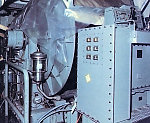
|
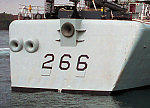
|
|
|
|
TIAPS
|
|
Role
|
Passive with tactical
low frequency active towed array sonar
|
Fitted to
|
Still in development, intended for HALIFAX
class frigates
|
Range
|
??
|
Approximate Cdn. Service Dates
|
Still in development
|
Comments
|
According to the DRDC website: "The towed
integrated active-passive sonar (TIAPS) would combine a
state-of-the-art passive towed array sonar with a tactical
low-frequency active (LFA) towed-array sonar. Both deep and shallow
water capability at tactical speeds is anticipated. TIAPS promises
improved detection ranges against the modern, quiet submarine through
the use of low frequency sound, which propagates better underwater.
TIAPS will demonstrate recent advancements in data fusion, automatic
tracking and assisted localization, and will interface with the host
ship’s command and control system."
|
Sources
|
DRDC
Atlantic website
|
Photos
|
1.
|
2.
|
3.
|
|
|
|
|

Additional Sources:
Barrie, Ron and Macpherson, Ken. (1996). Cadillac of
Destroyers: HMCS ST. LAURENT and Her Successors.
Vanwell Publishing Ltd. St. Catherines, Ont.
Gough, Barry M. (2001). HMCS HAIDA - Battle Ensign Flying
. Vanwell Publishing Ltd. St. Catherines, ON.
Steed, Roger G. (1999). Canadian Warships Since 1956.
Vanwell Publishing Ltd. St. Catherines, ON.
Jane's Fighting Ships, Various Editions
Conway's All The World's Fighting Ships, Various Editions
Corvus Publishing Group / Canada's Navy Annual.
Various
Issues. (1985-1991)
ASDIC, RADAR, and IFF
Systems Aboard HMCS HAIDA website by Jerry Proc.
With information from the files of Mike Potter.
Correspondence with B. Lake and M. Healey.
Photos from M.D. Thomas.
|
